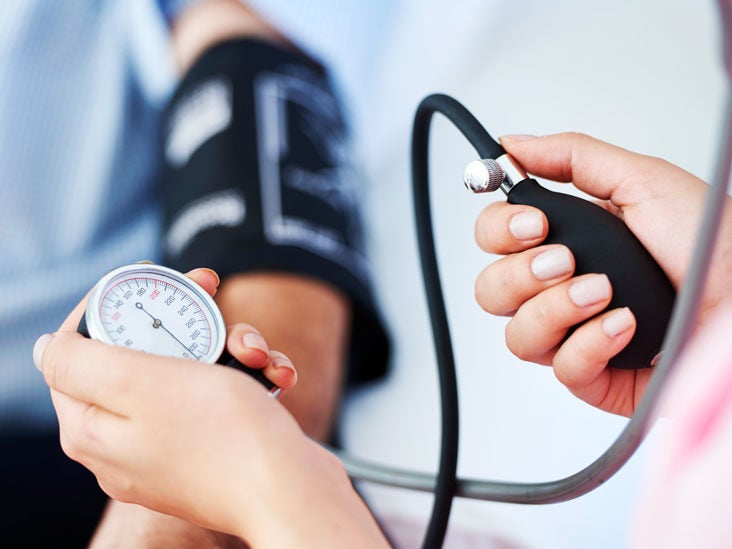Isolated Diastolic Hypertension who are at risk of complications such as stroke and heart attack have an elevated diastolic blood pressure (DBP) reading of 90 to 99 millimeters of mercury (mm Hg). Isolated diastolic hypertension occurs when the systolic blood pressure is normal, and the DBP is elevated.
According to a recent study, it has been revealed that isolated diastolic hypertension is the most prevalent form of hypertension in the USA, with a prevalence of 15.4%. Also, this type of hypertension can lead to cardiac arrhythmias, cerebrovascular events, and heart failure.
The number of people living with isolated diastolic hypertension has increased from 2 million in 2010 to 3.8 million in 2016. The rise in the prevalence of isolated diastolic hypertension is partly due to a greater awareness of the condition among healthcare providers and an increased use of ambulatory blood pressure monitoring and other diagnostic tools.
Isolated Diastolic Hypertension (IDH) is determined when the diastolic blood pressure falls below 60 mm Hg and there are no signs or symptoms of organ damage or disease. This can cause a misdiagnosis of “healthy” individuals as having IDH. Many patients may not even be aware that they have this condition.
Isolated diastolic hypertension is a condition in which blood pressure is higher when blood pressure is measured during exercise than when it is calculated while sitting still.
A study has found that people with isolated diastolic hypertension (IDH) have an increased risk of heart attack, stroke, and cardiovascular death.
According to the study, IDH was linked to 4.8 times greater risk of heart attack, 3.6 times greater risk of stroke, and 2.3 times greater risk of cardiovascular death than people who did not have IDH.

Isolated Diastolic Hypertension
High blood pressure is a serious health condition, and isolated diastolic hypertension is a common cause. In this article, I’ll review isolated diastolic hypertension, discuss the symptoms, and provide advice to thossufferinger from this condition.
Isolated diastolic hypertension is a common problem among people. It’s also called masked hypertension since the patient doesn’t have symptoms.
If you’re a doctor who works with patients with heart disease, you need to know this: Isolated diastolic hypertension (IDH) is the most common form of high blood pressure in your patients.
What is IDH? And what does it have to do with your heart? In this article, I’ll explain how IDH differs from normal hypertension and what you should do to prevent complications.
Did you know there are several ways to treat Isolated Diastolic Hypertension (IDH)? In this post, I will share what IDH is t, different treatments, and available medications to help manage your blood pressure.
In this post, I will share what IDH is, the different treatments, and available medications to help manage your blood pressure.
The good news is that IDH can be treated and controlled using a combination of lifestyle changes and medication.
But, it’s important to note that some people may not respond to medical treatment, and others may not be able to tolerate the side effects of medications.
So, if you have IDH and want to control your blood pressure, it’s important to consider the options available to you.
Causes
Isolated diastolic hypertension (IDH) is a condition in which your blood pressure is normal, but your pulse is elevated. In many cases, it is temporary and doesn’t require treatment.
However, if IDH persists for six months or longer, it can cause damage to your heart. This is why you should seek medical care if you experience any symptoms associated with the condition.
To understand what causes IDH, you’ll need to know the difference between systolic and diastolic blood pressure.
Systolic refers to the top number on the blood pressure chart, while diastolic refers to the bottom number. Blood pressure is measured in millimeters of mercury (mm Hg).
The systolic and diastolic numbers are below 120 mm Hg in a person with normal blood pressure.
When someone has a systolic reading between 120 mm Hg and 139 mm Hg, they have isolated systolic hypertension.
It’s one of those conditions that are very common, yet very little is known about it. As a result, people may not know what to expect, and the health professionals they see won’t be able to give them any useful advice.
But isolated diastolic hypertension isn’t a normal condconditionserious risk factor for heart disease.
The good news is that it doesn’t necessarily meayou’llto get sick. But you need to take steps to reduce your risk of developing problems like heart failure or stroke.
This is a good topic to explore because it can often go undiagnosed. There are two types of hypertension: systolic and diastolic.
Systolic hypertension involves high blood pressure during systole. This means that blood pressure is higher when the heart beats. When the core beats normally, it pumps blood through the arteries and out of the lungs.
If the heart rate is slower than normal, blood pressure is higher. When blood pressure is higher during diastole, the heart has to pump more blood per heartbeat to compensate. This is known as diastolic hypertension.
Diastolic hypertension is not considered a disease. It is only a risk factor.
High blood pressure is a risk factor for several health conditions, including heart disease, stroke, and kidney disease.
Symptoms of hypertension include headaches, dizziness, shortness of breath, fatigue, chest pain, or other heart-related symptoms.
Your doctor may recommend a 24-hour blood pressure monitor to see whether the high blood pressure is causing a problem.

Symptoms
Isolated diastolic hypertension (IDH) is a common medical condition affecting millions worldwide.
While it is sometimes referred to as “silent” hypertension, it can be detected early and treated effectively. IDH often causes no symptoms and is commonly overlooked by healthcare professionals.
It is very important to look for signs of IDH, as it can lead to serious health problems if left untreated.
IDH is not a disease that needs a cure; treatment may relieve symptoms and help prevent complications.
Diastolic blood pressure (DBP) measures the pressure in the arteries when the heart relaxes between beats. It is calculated by taking a reading between the heartbeats. This is done after resting for at least five minutes.
Many people think high blood pressure is only dangerous when it is systolic. However, diastolic blood pressure is a stronger predictor of cardiovascular disease than systolic blood pressure.
It has been shown that people with isolated diastolic hypertension are at a much higher risk of developing cardiovascular diseases compared to those without it.
So if you are concerned about your blood pressure, talk to your doctor. You may be able to take steps to lower it.
Treatment
High blood pressure is a very common condition. It’s one of the most common chronic diseases and one of the easiest to treat.
However, not everyone gets high blood pressure. Most people don’t.
Most of us have blood pressure that fluctuates throughout the day. Sometimes it’s low; sometimes, it’s high.
You’re likely to suffer from high blood pressure when blood pressure is consistently high. If you are, you may be surprised to learn that there are a few different types of high blood pressure.
It’s important to know which type you have to treat appropriately.
Many people are surprised when they first hear about isolated diastolic hypertension (IDH). However, there is a lot of confusion surrounding the definition of IDH. I’m going to clear things up for you right now!
There are three main definitions of IDH, and they are very different; I will explain them in this article s so you can understand exactly what it means.
Definition 1: IDH is a condition where you have normal blood pressure but an abnormally high pulse.
Definition 2: IDH is a condition where you have normal blood pressure but a low pulse.
Definition 3: IDH is a condition where you have normal blood pressure but an abnormally low pulse.
So what does this mean? Isolated diastolic hypertension is a condition where you have normal blood pressure but you have a low pulse. This doesn’t mean that you have heart disease, just that your pulse rate is lower than normal.

Frequently Asked Questions (FAQs)
Q: How did you become aware of this condition?
A: I was diagnosed with isolated diastolic hypertension in 2015. I was on track to becoming a nurse, but when my mother told me about it, I realized it had gone undiagnosed for years.
Q: How would you describe this condition?
A: This is a condition where your blood pressure isn’t high enough to make you need medication, but it is high enough to lead to problems. It can cause your heart to become weak. If left untreated, it can lead to heart failure.
Q: What are some signs of this condition?
A: Signs include headaches, fatigue, and feeling tired all the time.
Q: What is the cause of this condition?
A: The cause of isolated diastolic hypertension is not fully understood, but it could be hereditary.
Q: What is isolated diastolic hypertension?
A: It’s when there is no diastolic pressure, and the systolic pressure is high.
Q: How is it diagnosed?
A: Doctors usually look at blood pressure in the morning. If your anxiety is normal and drops as the day progresses, it’s most likely not hypertension. If your concern deepish and tis here are no symptoms, it’s most likely not hypertension.
Q: Does this condition go away on its own?
A: If the pressure is high, the patient must stop drinking alcohol and avoid stress. If the pressure doesn’t go down, they should consult a doctor.
Myths About Hypertension
1. Isolated Diastolic Hypertension (IDH) is not a serious condition.
2. IDH is not associated with cardiovascular disease.
3. IDH does not require treatment.
Conclusion
As a result, isolated diastolic hypertension may significantly cause morbidity and mortality. In particular, it is a cardiovascular and end-stage renal disease risk factor. Therefore, isolated diastolic hypertension should be treated aggressively.
It’s very important to diagnose this condition early and treat it appropriately. This condition can lead to heart attacks, strokes, and end-stage renal disease if left untreated.
Diastolic hypertension refers to high blood pressure during rest. It is a condition that affects about half of all people over age 65.
The good news is that diastolic hypertension can often be treated with a low dose of a single antihypertensive medication. This is why it’s important to monitor blood pressure at home regularly.
You may have heard that diastolic hypertension is a risk factor for heart disease. That’s true. However, recent studies suggest that diastolic hypertension isn’t as harmful as previously thought.
So, if you have isolated diastolic hypertension, it’s important to monitor your blood pressure and seek treatment as soon as possible.
 Fit Netion My WordPress Blog
Fit Netion My WordPress Blog



